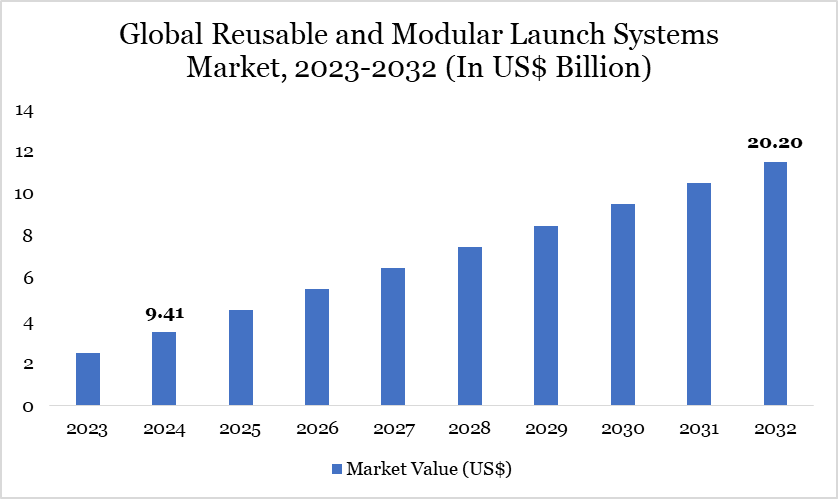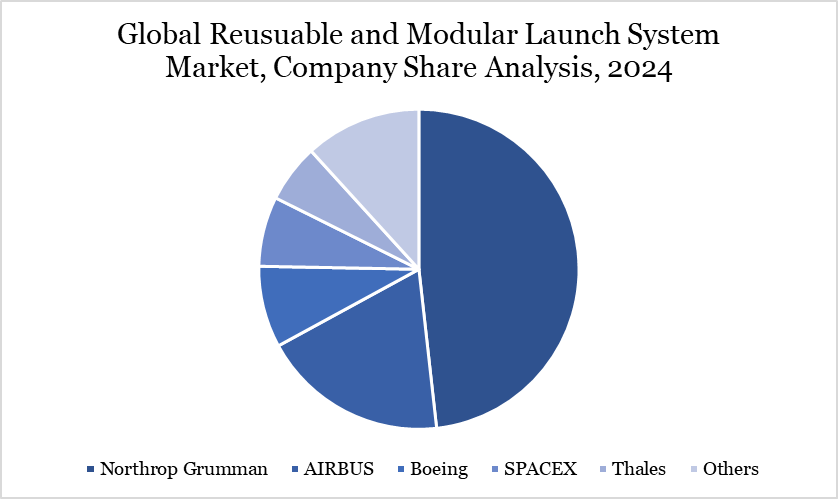Reusable and Modular Launch Systems Market Size
Reusable and Modular Launch Systems Market Size reached US$ 9.41 billion in 2024 and is expected to reach US$ 20.20 billion by 2032, growing with a CAGR of 10.02% during the forecast period 2025-2032.
The global reusable and modular launch systems market is driven by the growing emphasis on sustainable and environmentally responsible space operations. As concerns about space debris, carbon emissions and resource consumption intensify, both governments and private space companies are shifting toward technologies that minimize environmental impact. Reusable systems significantly reduce the amount of discarded rocket hardware and lower the carbon footprint associated with manufacturing new launch vehicles for every mission.
Reusable and Modular Launch Systems Market Trend
One key trend in the global reusable and modular launch systems market is the integration of AI and automation for rapid turnaround and autonomous landing operations. Companies are increasingly leveraging artificial intelligence, machine learning and advanced sensors to enhance the precision and efficiency of rocket recovery, refurbishment and relaunch.
This trend not only shortens the turnaround time between launches but also improves safety, reduces human intervention and lowers operational costs. For example, SpaceX uses AI-driven algorithms and autonomous drone ships like "Of Course I Still Love You" to recover boosters at sea with remarkable accuracy.

For more details on this report, Request for Sample
Market Scope
| Metrics | Details |
| By System Type | Reusable Launch Systems (RLS), Modular Launch Systems |
| By Launch Platform | Ground-based Launch, Air-launched Systems, Sea-based Launch |
| By Application | Satellite Deployment, Cargo & Resupply Missions, Manned Space Missions, Space Tourism, Others |
| By Propulsion Type | Liquid, Solid, Others |
| By End-User | Commercial Space Companies, Government Space Agencies, Defense Organizations, Research & Academic Institutions |
| By Region | North America, South America, Europe, Asia-Pacific, Middle East and Africa |
| Report Insights Covered | Competitive Landscape Analysis, Company Profile Analysis, Market Size, Share, Growth |
Reusable and Modular Launch Systems Market Size Dynamics
Growing Demand for Low-Cost Satellites and Frequent Launches
One key driver for the global reusable and modular launch systems market is the increasing demand for low-cost and frequent satellite launches, especially from the telecommunications, Earth observation and defense sectors. As the number of small satellite constellations—such as Starlink, OneWeb and Amazon’s Project Kuiper—continues to rise, there is a growing need for affordable and rapid launch solutions.
Reusable and modular launch systems offer a significant cost advantage by allowing multiple flights with the same hardware, reducing launch prices and increasing scheduling flexibility. For instance, SpaceX’s Falcon 9 has repeatedly demonstrated the economic and operational benefits of reusability by slashing the cost per launch to under US$ 30 million, compared to traditional expendable vehicles that often exceed US$ 60 million. This capability enables more frequent launches to meet the surge in demand from both commercial and government clients.
High Development Costs
One major restraint for the global reusable and modular launch systems market is the high upfront development cost and technical complexity associated with achieving reliable reusability. Designing launch vehicles that can withstand multiple launches and reentries requires advanced materials, thermal protection systems and precision engineering—all of which significantly increase initial investment and R&D expenditures. This makes it challenging for new entrants and smaller space agencies, particularly in developing countries, to compete with established players like SpaceX or Blue Origin.
For example, while SpaceX has demonstrated repeated reusability with its Falcon 9, it took nearly a decade of iterative development and billions of dollars in investment to achieve this milestone. Additionally, the refurbishment process between launches—although cheaper than building new rockets still involves rigorous inspection, part replacement and maintenance, which can eat into cost savings if not optimized at scale.
Reusable and Modular Launch Systems Market Segment Analysis
The global reusable and modular launch systems market is segmented based on system type, launch platform, application, propulsion type, end-user and region.

Rising Demand for Cost-Efficient Satellite Deployment Drives Commercial Space Agencies
A key driver for commercial space agencies in the global reusable and modular launch systems market is the rising demand for cost-efficient satellite deployment and commercial payload services. Private companies across the globe—such as SpaceX (USA), Arianespace (France), ISRO’s commercial arm NSIL (India) and Galactic Energy (China)—are increasingly adopting reusable and modular launch systems to remain competitive in the rapidly expanding commercial satellite and small sat markets.
By leveraging reusability, these agencies can significantly reduce per-launch costs, increase launch frequency and offer more flexible services to a growing client base that includes telecom providers, Earth observation firms and government agencies. Recent developments highlight this momentum. For example, Galactic Energy’s Ceres-1S became China’s first sea-based launch of a commercial reusable rocket in 2023, signaling the country’s push toward sustainable and cost-effective space operations.
Reusable and Modular Launch Systems Market Geographical Share
Strong Presence of Private Space Companies in North America
One key driver for the reusable and modular launch systems market in North America is the strong presence of private space companies actively investing in reusability to lower costs and increase launch cadence. Companies like SpaceX, Blue Origin and Rocket Lab USA have revolutionized the regional space ecosystem by pioneering partially and fully reusable launch systems.
For instance, SpaceX’s Falcon 9 has become a global benchmark for launch reusability, with over 20 reuses of a single booster achieved as of 2024, drastically reducing per-launch costs and environmental impact. This has enabled a surge in satellite deployment missions, commercial contracts and public-private partnerships with NASA and the US Department of Defense.
Sustainability Analysis
The global reusable and modular launch systems market significantly advances sustainability in the space industry by reducing waste, cost and environmental impact. Traditional expendable launch systems create substantial material waste and contribute to space debris, while reusable systems such as SpaceX's Falcon 9 and Falcon Heavy allow for multiple reuses of key components like the first-stage booster. This approach not only lowers manufacturing emissions but also decreases launch costs and frequency of production cycles.
Similarly, Rocket Lab's Neutron and Blue Origin’s New Glenn are being developed with full or partial reusability, reinforcing the shift toward environmentally conscious engineering. The modularity of these systems further supports circular economy principles, as interchangeable components can be refurbished or upgraded instead of being discarded. This trend aligns with global sustainability goals, including reducing carbon footprints and promoting responsible consumption and production.
Reusable and Modular Launch Systems Market Major Players
The major global players in the market include Northrop Grumman, AIRBUS, Boeing, SPACEX, Thales, Blue Origin, China Aerospace Science and Technology Corporation (CASC), Rocket Lab USA, Arianegroup and Virgin Galactic.

Key Developments
- In 2024, the Union Cabinet chaired by the Prime Minister Shri Narendra Modi has approved the development of Next Generation Launch Vehicle (NGLV), that will be a significant step towards the Government’s vision of establishing & operating the Bharatiya Antariksh Station and towards developing capability for Indian Crewed Landing on the Moon by 2040.
- In 2024, the China Aerospace Science and Technology Corporation (CASC), a state-owned contractor, plans to launch two large-diameter reusable rockets in 2025 and 2026. CASC plans to launch a four-meter and five- meter diameter rockets in 2025. To put that into context, SpaceX’s Falcon Heavy, the company’s biggest launch vehicle in operation currently, has a diameter of about 3.66 meters.
Why Choose DataM?
- Data-Driven Insights: Dive into detailed analyses with granular insights such as pricing, market shares and value chain evaluations, enriched by interviews with industry leaders and disruptors.
- Post-Purchase Support and Expert Analyst Consultations: As a valued client, gain direct access to our expert analysts for personalized advice and strategic guidance, tailored to your specific needs and challenges.
- White Papers and Case Studies: Benefit quarterly from our in-depth studies related to your purchased titles, tailored to refine your operational and marketing strategies for maximum impact.
- Annual Updates on Purchased Reports: As an existing customer, enjoy the privilege of annual updates to your reports, ensuring you stay abreast of the latest market insights and technological advancements. Terms and conditions apply.
- Specialized Focus on Emerging Markets: DataM differentiates itself by delivering in-depth, specialized insights specifically for emerging markets, rather than Propulsion Type generalized geographic overviews. This approach equips our clients with a nuanced understanding and actionable intelligence that are essential for navigating and succeeding in high-growth regions.
- Value of DataM Reports: Our reports offer specialized insights tailored to the latest trends and specific business inquiries. This personalized approach provides a deeper, strategic perspective, ensuring you receive the precise information necessary to make informed decisions. These insights complement and go beyond what is typically available in generic databases.
Target Audience 2024
- Manufacturers/ Buyers
- Industry Investors/Investment Bankers
- Research Professionals
- Emerging Companies